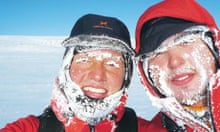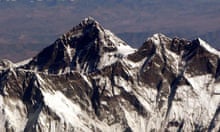It was an act of physical courage and daring that made headlines, but dramatic new details of last week's successful attempt by a 22-year-old to become the youngest British woman to climb Everest reveal that it nearly ended in tragedy.
First reports had suggested Bonita Norris, who climbed the world's highest peak on Monday, had suffered only a minor back injury during her descent. But the Observer has learned that Norris, a media studies graduate from Berkshire, could have died but for the efforts of the Sherpas and her support team, who carried her part of the way down the mountain after she temporarily lost the use of her legs in the "death zone".
Few live to tell the tale of an incapacitating injury in the infamous stretch which starts at about 7,500m above sea level and carries its dark nickname because no one can survive there for more than a few hours.
"It was a huge day, not something I would want to do again," said Kenton Cool, the 36-year-old professional mountaineer whose climbing company helped Norris achieve her dream. "I do everything in my power to make sure people come back safe, but there is no such thing as a risk-free climb. I have lost an unbelievable amount of weight, my voice has almost gone, the feeling in the ends of my fingers suggest I have the early stages of frostbite. It's taken its toll on my body and it will take Bonita a little while to recover."
The drama had started the previous day when, having achieved a near-textbook ascent and in high spirits, Norris slipped while coming down the mountain, sustaining whiplash.
Unable to move, her legs quickly became frozen and she could not feel her toes – the first signs of frostbite. After several hours her Sherpa, Lhakpa, informed her support team via a radio link that her condition had become a major cause for concern and he feared she would be unable to come down from the mountain on her own. Extra Sherpas were sent up the mountain with oxygen, medical equipment, food and hot drinks as the support team farther down waited for further information.
Cool decided to follow the Sherpas up the mountain escorted by a Maltese doctor, Greg Attard, despite the pair of them having descended from the summit only hours before. Around midnight – 12 hours after Norris's ascent – Cool found her. "I'm so sorry for causing you trouble," said Norris. "I slipped on my way down, it was really stupid of me."
Cool said: "It was a shocking situation. She was lucid but semi-conscious. She recognised me straight away; that was amazing given how long she had been at altitude. But my initial reaction when I saw the way the Sherpas were banging her legs and giving her hot water was, 'Oh my God, she has severe frostbite'."
He feared Norris might have some sort of respiratory problem caused by being at altitude for too long. "We sat her up, stripped her top off, cut a bit from her thermals," he said. "It was medicine on the edge." Attard injected 15mgs of the steroid dexamethasone into her arm. "I'm so glad Greg was there," Cool said. "I've injected oranges in practice but never injected somebody for real in the dark at -20C, 8,250m above sea level in the snow. It bloody well worked and got her on her feet."
Lhakpa and another Sherpa, Dorje, had previously lowered Norris down a line of rope attached to the mountain from a section at 8,500m known as "the balcony". In the process they lost radio contact with the support team for around five hours as they descended a stretch of Everest close to the Tibetan-Chinese border.
"They had bound her up, tied her legs together and lowered her down by her climbing harness because she was unable to walk," Cool said. "This is one of the most harrowing things I've experienced, but the one good thing was the emergency procedures worked really well. The Sherpas and support team were fantastic. It was a pretty precarious situation. One simple slip and they could have all been down the line. The Sherpas were laying everything on the line to get her back down."
Norris could not be lowered further over the rough terrain that followed. Cool, whose voice was so hoarse from his efforts he had difficulty talking to the Observer, descended the mountain to fetch a sledge to drag her down. However, by the time he had returned, the injection had kicked in and Norris was able to move, albeit slowly and supported by Cool and the Sherpas.
When Cool was able to examine Norris's toes in a tent farther down the mountain, he was relieved. "She's got some mild frostbite on two of her toes but when I first saw her I thought she was going to lose all her toes," he said. Norris was said to be in good spirits and had managed to drink a beer with some of her rescuers since returning to base camp.
It was the end to an epic 48 hours on the world's highest mountain, much of it spent outside a tent and in the death zone. While the story is likely to raise the telegenic Norris's profile further when she returns to the UK some time in the next fortnight, after treatment in hospital, it is bound to reignite the debate about the merits of allowing relatively inexperienced climbers on Everest. About 60 people were climbing Everest the day Norris reached the summit. This weekend about 140 people are expected to attempt the climb.
Cool was at pains to stress Norris was not a novice, having trained in the Alps and climbed Mount Manaslu in Nepal four months ago. But he conceded Everest was a "honeypot". "People flock here because it's easy to get sponsorship, kudos, recognition from peers," he said. "You do see more and more people here on Everest who I believe shouldn't be here. There are people here who have never worn crampons or a harness and think you can just spend thousands of dollars and that's it, but Bonita was not one of these people."
Cool, who broke his own British record last week when he completed his eighth ascent of Everest, said the mountain's fame may have saved Norris's life. "It's a very safe mountain because the commercial teams here have the experience and the manpower to cope with emergencies so that a simple slip doesn't manifest itself in disaster.
"But if it had happened on a really small mountain, perhaps she wouldn't be alive. I have lost 36 friends but not one on Everest."




